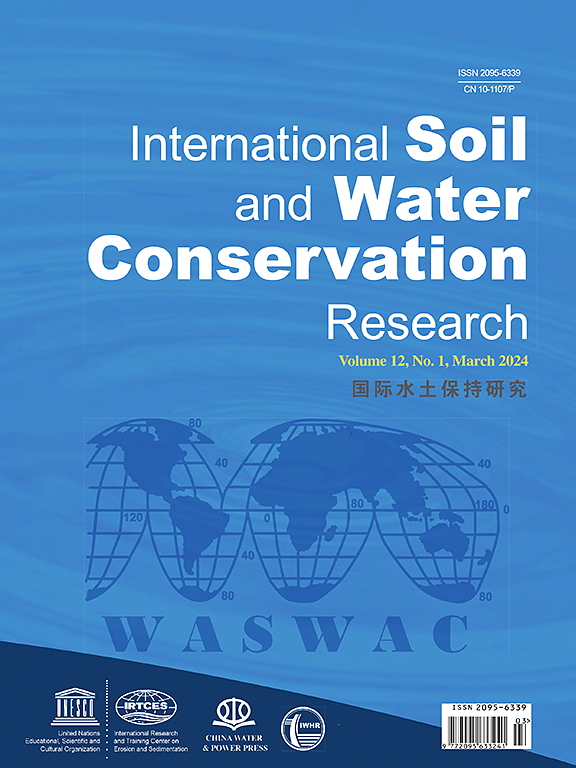Improving SOC estimation in low-relief farmlands using time-series crop spectral variables and harmonic component variables based on minimum sample size
IF 7.3
1区 农林科学
Q1 ENVIRONMENTAL SCIENCES
International Soil and Water Conservation Research
Pub Date : 2025-01-24
DOI:10.1016/j.iswcr.2025.01.005
引用次数: 0
Abstract
Efficiently monitoring Soil Organic Carbon (SOC) in farmlands is crucial for environmental and agricultural sustainability. Currently, crop spectral variables are primarily employed to estimate SOC in low-relief farmlands. To enhance SOC estimation, further crop information needs to be excavated. Additionally, few studies have considered the sample size in modeling SOC estimation, which may lead to precision loss and cost waste. Therefore, this study proposed a novel method to improve SOC estimation in low-relief farmlands. This method considers more information on crop growth and minimum sample size. The results showed that: (1) time-series NDVI was established as the characteristic crop spectral variables, based on crop spectral variables extracted from eight-day time-series reflectance products. (2) Seventeen harmonic component variables were derived from time-series NDVI via Fourier transformation. (3) Six crop spectral variables and seven harmonic component variables were determined as the optimal SOC estimators. (4) The convolutional neural network model provided higher SOC estimation accuracy (R2 = 0.81, NRMSE = 7.09%) than the random forest model and the back propagation neural network model. And the minimum sample size based on the optimal model was determined to be 250. (5) The proposed method improved SOC estimation at the regional scale, achieving a 2.54% reduction in NRMSE compared to the NDVI-based model. These findings suggest that the proposed method holds the potential for efficient SOC estimation in low-relief farmlands.
基于最小样本量的时间序列作物光谱变量和谐波分量变量改进低起伏农田有机碳估算
有效监测农田土壤有机碳(SOC)对环境和农业可持续发展至关重要。目前,作物光谱变量主要用于低洼农田土壤有机碳的估算。为了提高土壤有机碳的估算,需要挖掘更多的作物信息。此外,很少有研究在建模SOC估算时考虑样本量,这可能导致精度损失和成本浪费。因此,本研究提出了一种改进低洼农田土壤有机碳估算的新方法。这种方法考虑了更多关于作物生长和最小样本量的信息。结果表明:(1)基于8 d时间序列反射率产品提取的作物光谱变量,建立了时间序列NDVI作为特征作物光谱变量。(2)对时间序列NDVI进行傅里叶变换,得到17个谐波分量变量。(3)确定了6个作物光谱变量和7个谐波分量变量作为土壤有机碳的最优估计量。(4)卷积神经网络模型的SOC估计精度(R2 = 0.81, NRMSE = 7.09%)高于随机森林模型和反向传播神经网络模型。根据最优模型确定最小样本量为250。(5)与基于ndvi的模型相比,该方法改进了区域尺度上的有机碳估算,NRMSE降低了2.54%。这些结果表明,该方法具有在低起伏农田进行高效有机碳估算的潜力。
本文章由计算机程序翻译,如有差异,请以英文原文为准。
求助全文
约1分钟内获得全文
求助全文
来源期刊

International Soil and Water Conservation Research
Agricultural and Biological Sciences-Agronomy and Crop Science
CiteScore
12.00
自引率
3.10%
发文量
171
审稿时长
49 days
期刊介绍:
The International Soil and Water Conservation Research (ISWCR), the official journal of World Association of Soil and Water Conservation (WASWAC) http://www.waswac.org, is a multidisciplinary journal of soil and water conservation research, practice, policy, and perspectives. It aims to disseminate new knowledge and promote the practice of soil and water conservation.
The scope of International Soil and Water Conservation Research includes research, strategies, and technologies for prediction, prevention, and protection of soil and water resources. It deals with identification, characterization, and modeling; dynamic monitoring and evaluation; assessment and management of conservation practice and creation and implementation of quality standards.
Examples of appropriate topical areas include (but are not limited to):
• Conservation models, tools, and technologies
• Conservation agricultural
• Soil health resources, indicators, assessment, and management
• Land degradation
• Sustainable development
• Soil erosion and its control
• Soil erosion processes
• Water resources assessment and management
• Watershed management
• Soil erosion models
• Literature review on topics related soil and water conservation research
 求助内容:
求助内容: 应助结果提醒方式:
应助结果提醒方式:


